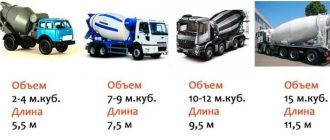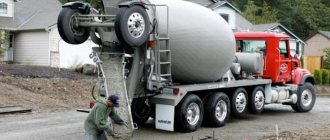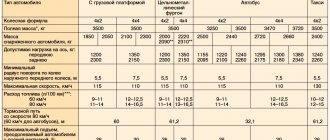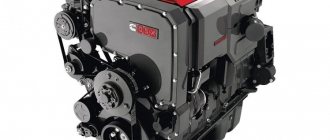When calculating how many cubes of concrete are in a KamAZ mixer, you can find out what the capacity of a concrete mixer truck (concrete mixer truck, concrete truck) is and how many trucks will be needed to transport the volume of concrete required for construction. The need for transportation is determined by the following factors:
- the concrete solution prepared manually at the construction site has worse quality and technical parameters than the one made in a KamAZ mixer at a specialized plant;
- thanks to the concrete mixer, the solution remains homogeneous, does not separate, does not splash, and does not leak along the way from the plant to the construction site.
Types of KAMAZ mixers and their capacity of concrete cubes.
An industrial mixer is a truck with a pear-shaped drum installed on it, designed for mixing and transporting concrete mortar. This mechanism is mounted on a semi-trailer and is equipped with a separate drive. This fact allows it to be used after being separated from the machine and installed on the construction site.
When comparing types of concrete mixers, you should pay attention to the following basic parameters:
- drum volume expressed in m3;
- the length of the sleeve;
- weight of loaded equipment.
The Kama Automobile Plant produces gravity reversible ABS models based on the KamAZ 65115, 69343, 63963, 53229-15 and others chassis, with various technical characteristics and a mixer volume of 5-12 m³. The most popular equipment is with a pear size of 9 m³.
As for the mass, a 7 cc mixer. m weighs 12 tons, mixer 5 cubic meters. m – 11. Concrete volume 1 cubic. m weighs 2.4 tons. Accordingly, a 7 cubic meter mixer. m will weigh about 29 tons, and 7 cubic meters. m – 23 tons. This must be taken into account when ordering a concrete mixer truck, because not every road surface and construction site can withstand such weight.
The characteristics of popular models are shown in the table:
| Specifications | KamAZ-65115-3958 | KamAZ 53229-15 | 69363B (ABS-5DA) on KAMAZ-55111 6x4 chassis |
| Water tank capacity, l | 650 | 450 | 600 |
| type of drive | Hydromechanical transmission power take-off from the chassis engine (CUMMINS) through an independent power take-off (PTO) | Hydromechanical with power take-off from an autonomous engine | Hydraulic from an autonomous engine D-144 |
| Mixing drum rotation speed, rpm. | 0…14 | 0…18 | 0-14 |
| Mixing drum loading height, mm | 3560 | 3700 | 3530 |
| Concrete mixture unloading height, m | 0,15-2,2 | 0,5-2 | 0-2 |
| Geometric volume of the mixing drum, m3 | 6 | 7 | 9 |
| Overall dimensions (length x width x height), mm | 8500 x 2500 x 3600 | 9000 x 2500 x 3700 | 7500 x 2500 x 3500 |
Calculation of the amount of solution?
In order to calculate how much concrete goes into the mixer, you need to know several parameters: the weight of special equipment, the mass of one ton of concrete. To do this, you need to calculate the total load that is exerted on the road surface.
How much does a cube of concrete cost in a mixer and what is its volume? As a rule, 1 m3 of concrete material weighs only 2.4 tons. A structure with a volume of 7 m3 can accommodate only 12 tons. That is, the total mass will be 29 tons. A device with a volume of 5 m3 fits 11 tons, that is, the total weight is 23 tons.
When calculating how many cubes of concrete are in a KamAZ-based mixer, you must take into account that the more material you need, the larger special equipment you will need.
The advantages of KAMAZ mixers include:
- Versatility. When using a concrete truck, it is possible to provide concrete for small private construction or large multi-story buildings.
- Mobility. As noted above, the main positive aspect of using a mixer remains the ability to transport concrete mortar over long distances. If a car is completely loaded with concrete, its speed will be 60 km/h. At the same time, the transportation process does not imply any influence on the material by environmental factors.
- Speed of obtaining concrete solution. The presented equipment is capable of preparing a solution directly at a construction site in a short period of time.
- Convenient unloading. If you use a concrete truck with a hose to transport material, you can not only deliver the goods, but also pour them into the formwork.
- Economical. This positive point is achieved due to the fact that while receiving the concrete mixture, the delivery process is also carried out. As a result, the cost of such transportation will be low, in contrast to the preparation of concrete mortar using stationary equipment in a factory.
Factors to consider when ordering concrete in a mixer.
Knowing the amount of mortar in the KAMAZ required to pour the foundation, and how many cubes of concrete are in the mixer, it is easy to calculate the required number of trips. But here we must take into account the fact that in mixers that are used without following the appropriate rules, concrete can remain on the walls and dry out.
Therefore, instead of the ordered quantity, you can receive one ton of solution less.
The following rules will help you avoid this:
- Choose newer and well-maintained cars.
- Make sure that after draining the solution, the drum is thoroughly rinsed with water.
- Record the time of concrete unloading and calculate its quantity, knowing that 1 m3 of solution flows out within 10 minutes.
Following these rules, you can easily calculate how much concrete a KAMAZ mixer actually contains.
This is interesting: Putzmeister M740 - technical characteristics of a concrete pump
Types of concrete mixer trucks
All concrete mixer trucks (ABC) are manufactured on the basis of trucks. General requirements for equipment are formalized in GOST 27339-2016 “Concrete mixer trucks”. To transport solutions, the vehicle is equipped with a mixing drum.
The volume of concrete drums varies from 3 to 15 m3. The inside of the container is equipped with blades for mixing the composition, loading and unloading it. Depending on the type of operation, the blades rotate in different directions.
Mixers installed on truck chassis differ in the following ways:
- Direction of solution unloading. It can be done forwards and backwards.
- Engine type. The mixer operates from an autonomous engine or by taking power from a truck engine.
- Drum drive. It can be mechanical (rarely used nowadays) or hydromechanical.
Most mixer models are equipped with special tray devices for unloading concrete in hard-to-reach places.
Concrete mixers can be installed on specialized chassis, as well as on semi-trailers, which must be aggregated with tractors.
The technical conditions for the production of ABS standardize the following indicators of this special equipment:
- overall dimensions and weight;
- drum volume (geometric and based on concrete solution output);
- mixer rotation speed;
- volume of the water tank heated by the exhaust gases of the chassis engine;
- mixer drive power;
- loading and unloading height, etc.
Structures – self-loading concrete mixer truck China
The self-loading self-propelled concrete mixer has a compact structure and is mainly composed of six parts : Under the mixer there is a chassis, which is designed to support the mixer. The powerful motor of the concrete mixer with skip hoist can provide power and ensure that the machine can work efficiently. The mixing drum is driven by a powerful motor and ensures fast mixing, high quality mixing. The hydraulic system of this self-propelled concrete mixer device is the core of unloading materials, this unloading method has been widely used. And its discharge speed is quite fast, which can effectively save construction costs. An independent water supply system can continuously supply water to ensure the normal operation of the machine. The operating room space is small, but can provide an ideal workflow. It has an attractive appearance and compact structures, all compositions fully interact with each other and work efficiently.
Parts of Self Loading Concrete Mixer
Nuances when delivering concrete by mixers
By calculating the volume of concrete to be poured and knowing how many cubes of concrete are in the Kamaz mixer of the material manufacturer you hired, you can simply and quickly calculate the number of trips. However, we must take into account the fact that some suppliers are dishonest, resulting in violations of equipment care rules. So, if the inner surface of the mixer drum is not washed after draining the load, the concrete remaining on its walls hardens and significantly reduces the amount of “usable” material for subsequent deliveries.
- Approximate calculation based on the weight of concrete. According to trade rules, the machine must be “packed” (weighed) before loading the material. After loading, the machine is weighed again, and the amount of loaded material is indicated on the cargo bill. Knowing the weight of the material, you can calculate its volume. To do this, the mass of the solution in kilograms (from the invoice) is divided by the approximate density of concrete in kg/m3: 1800-2400 kg/m3 – heavy concrete; 500-800 kg/m3 lightweight concrete, 500 kg/m3 foam and ultra-lightweight concrete;
- By unloading time. On average, 1 m3 of concrete is unloaded within 10 minutes. Therefore, you can stand near the machine, note the time of unloading the machine in minutes and divide the resulting figure by 10 to determine how many cubes of material were brought to you (or not brought).
Moreover, both methods of verifying the integrity of a company can be implemented simultaneously, independently of each other. Such a check is especially relevant if you buy a significant amount of construction material - several or several dozen KAMAZ flights.
You can also ask if the company has a GPS tracking system for vehicle movement. As a rule, conscientious companies have such a system, which completely eliminates the partial unloading (theft) of material by the driver on the way to the customer.
Classification of structures
This equipment is classified according to several technical parameters. There are 3 main categories.
Based on the type of drive, a distinction is made between mechanical drive (almost not used nowadays) and hydraulic drive.
According to the type of location of the mixing plant. The front position for the driver is the most convenient. Thus, he monitors all processes without leaving the cabin. Rear unloading, in turn, is more common due to the low cost of the device. Requires the direct presence and control of the driver.
According to the source of traction. Drum rotation is the main function of the mixer. Thus, they distinguish:
- Autonomous traction. The tank moves independently, it is not connected to the main motor of the vehicle. This KAMAZ mixer works on the principle of transmitting engine force to the drum through a belt. At the same time, there is more noise, but the stirring is performed better;
- Combined traction. The drum moves only in conjunction with the operation of the machine. The main parameter is less noise and saving resources.
Technical characteristics of the capacity of different KamAZ models
The capacity of different models based on KamAZ is presented in the table:
| Specifications | Concrete mixer truck model | ||
| 58147Y | 58149W | 5814W2 | |
| Basic chassis | 6540 8×4 | 65201 6x4 | 65201 8x4 |
| Mixer capacity according to the output of the finished solution, m 3 | 7 | 9 | 12 |
| Unloading speed, m 3 /min | 2–4 / 7–8 | 1 | 1 |
| Unloading height, mm | 2150 | 400–2350 | 360–2310 |
| Loading height, mm | 3570 | 3800 | 3820 |
| Mixer rotation speed, rpm | 0–14 | 0–14 | 0–14 |
| Mixing drum drive type | hydromechanical with power take-off from the chassis engine through the PTO FH 9767 | hydromechanical with power take-off from the chassis engine through the PTO FH 9731 | |
| Water tank capacity, l | 600 | 800 | 800 |
| Gross vehicle weight, kg | 28200 | 33100 | 41000 |
| Curb weight, kg | 12425 | 13825 | 16425 |
| Length, mm | 8050 | 8800 | 10900 |
| Width, mm | 2500 | 2500 | 2550 |
| Height, mm | 3625 | 3800 | 3940 |
All models of KamAZ concrete mixer trucks have different loads, weight parameters and dimensions. The width of the vehicle remains unchanged, which is 2.55 m (large mixers) and 2.50 m (all others).
The volume of the concrete mixer is 7 m³, based on the KamAZ-4310 chassis
This is interesting: The rights of the operator of aerial platform and hydraulic lift
KamAZ concrete mixer trucks
Concrete mixer trucks, made on the KamAZ basis, are used to transport concrete mixture from the manufacturer to the construction site. By using such a machine, the mortar is also moved along the entire perimeter of the construction site. Thanks to constant rotation, the concrete mixture inside the mixer is maintained in a liquid state. The KamAZ automobile concrete mixer prevents the homogeneity of the solution from being disrupted and does not allow the mixture to be lost during transportation, loading and unloading.
Indicators affecting mixer capacity
The mixing drums of a concrete truck based on the KamAZ chassis have different capacities. The number of cubes of concrete in KamAZ depends on the model of special equipment and the type of its design. KamAZ concrete mixer trucks are available with drum volumes from 5 to 12 m
3
.
To provide concrete for large construction sites, special equipment with a capacity of 10–12 m is used
3
. It will be difficult for a vehicle with such a tank volume to enter a small-scale construction site.
It is more advisable to use equipment with a mixing drum of 6–9 m
3
. These standard sizes are the most popular and common among private developers.
Capacity of a concrete mixer based on KamAZ
When calculating how many cubes of concrete are in a KamAZ mixer, you can find out what the capacity of a concrete mixer truck (concrete mixer truck, concrete truck) is and how many trucks will be needed to transport the volume of concrete required for construction. The need for transportation is determined by the following factors:
- the concrete solution prepared manually at the construction site has worse quality and technical parameters than the one made in a KamAZ mixer at a specialized plant;
- thanks to the concrete mixer, the solution remains homogeneous, does not separate, does not splash, and does not leak along the way from the plant to the construction site.
Criteria for choosing a concrete mixer
The model range of KamAZ concrete mixer trucks includes more than 20 vehicles. Before choosing a specific model, consider the following:
Example of ABS technical characteristics
- Drum volume. The speed of movement of the concrete mixer, the amount of solution loaded into the mixer, and the load on the road surface depend on this indicator.
- Engine power.
- Patency.
- Full weight of the equipment. Not every large and loaded mixer can travel everywhere.
- Drum rotation speed.
Video: New concrete mixer trucks TZA
ABS technical specifications
The safety of the concrete mixture during transportation is ensured by the constant rotation of the drum, inside of which there is a mechanism with mixing blades. The mixer is unloaded by the reverse movement of the blades. When ordering a concrete mixer truck, you must consider the following characteristics:
- Drum volume. Manufacturers of construction equipment produce drums of various sizes: from mini-mixers of 2 m3 to large ones of 15 m3. Mixers of impressive volume are used in the construction of large-scale projects, for example, when pouring a foundation;
- Mixer filling capacity. Given the stated technical characteristics, it is worth considering that ABS is almost never filled to capacity. This is due to the tightening of fines for overloading since 2015. As a rule, the actual filling of the drum is 1-3% lower than the maximum;
- Sleeve or gutter length. The device through which concrete is unloaded from the mixer has a length of 1.5-2 m. Suppliers often offer elongated hoses, and the unloading time increases accordingly;
- Weight of loaded concrete mixer truck. This parameter is important when delivering within the city, where there are weight restrictions for special vehicles, as well as when driving the vehicle on viscous soil. In many cases, it is more economical to order two or three 6cc mixers instead of one for 12-15 m3.
What are the advantages of ordering a mixer?
The volume of concrete in the mixer is quite large. All components of the solution are mixed at the factory, loaded into a Kamaz and sent to the site. At the same time, the customer can be sure that the concrete exactly corresponds to the declared grade and all relevant parameters according to GOST. Concrete is delivered to the site in finished form and supplied to the pouring site.
Advantages of using a concrete mixer truck:
- Delivery of freshly prepared mixture directly to the site
- Exact compliance of the brand and technical characteristics with GOST
- Possibility of supplying the solution directly to the formwork
- Significant reduction in the share of manual labor - due to the absence of the need to prepare the mixture yourself and deliver it to the site (the solution is supplied through a chute)
- High speed of work implementation, absence of unnecessary seams, areas with low-quality concreting
- Delivery of concrete to any distance - small and large factories provide the service in Moscow and the regions, with precise adherence to transportation time
Concrete in KamAZ retains mobility, homogeneity, does not dry out and does not delaminate. Many modern models are equipped with pumps and various types of hoses to effectively move the mixture over a distance of several meters or more.
Requirements for transporting concrete
Requirements for the transportation of concrete solutions are specified in GOST 7473-2010 “Concrete Mixtures”.
What should be considered when transporting concrete mixtures:
- The solution must be moved in such a way that the possibility of its loss is excluded.
- The possibility of sediment entering the mixture should be eliminated.
- The transportation method must ensure that the mass remains homogeneous.
- The time planned for transportation should not exceed the period during which the properties of the mixture are preserved (mobility and brand strength).
Transporting concrete using truck mixers is an effective way. Even moving it over long distances, it is possible to ensure that the mixture does not separate. Conditions are created that protect the cargo from the effects of sunlight, rain and other atmospheric phenomena.
The use of concrete mixer trucks makes it possible to produce the solution on the way to the construction site. To do this, the required amount of dry components of the mixture and water (in a separate tank) are loaded into the drum.
When approaching the object (30...40 minutes before the finish), the dry ingredients are mixed with water, the concrete solution is ready for use.
What you should pay attention to
Before ordering a building mixture and calculating how much Kamaz concrete takes, you need to carefully prepare everything. After all, ready-made concrete will not stand for long and will begin to harden fairly quickly, so it must be used sparingly and not be distracted by other tasks.
What you need to do when ordering the mixture:
- Provide access roads for concrete mixers - you may need several unloading points (for significant volumes of monolithic work).
- Clear the area for parking the mixer, from where the supply will be carried out - it is desirable that the distance is 8 meters from the edge of the trench. The slope should not be more than 5%, the dimensions of the site should be at least 6 by 8 meters.
- Prepare all the tools for work - a vibrating plate for compaction, and other devices.
- Think about where the excess mixture will be drained - you can assemble formwork for some small structures (barbecue, fence, etc.).
- Order delivery only from trusted manufacturers, having previously read the reviews - after all, it will be difficult to control the volume of the mixture; a lot depends on the honesty and integrity of the supplier.
- It is better to plan delivery in the morning so that you have time to use up all the solution.
- If you need several mixers, you need to first draw up a schedule for the arrival of Kamaz trucks and a work plan. It is advisable to leave a gap of at least 2 hours between flights.
- When receiving the mixture, be sure to check the delivery note, a certain sample quality certificate for the solution, which indicates the brand, volume, etc.
Delivery of concrete mortar using a KamAZ mixer is an excellent opportunity to save time, money and effort by obtaining a high-quality mixture that meets all requirements.
Principle of operation
The operator drives the mixer to the materials storage area and places all the raw materials needed for production into the mixing drum with ladle. Then the mixing drum begins to mix all the materials, after the concrete mixing is completed, the operator sends the concrete mixture to the designated construction site, during transportation, the self-propelled concrete mixer will continue to mix the concrete to prevent the concrete mixture from freezing.
Device
The design features of an automobile concrete mixer are determined by the need to prevent precipitation from entering the finished concrete mixture. The safety and uniformity of concrete is achieved by rotating the drum during movement.
The mixing drum is installed on the KamAZ chassis at an angle of 10 degrees. Special spiral blades are installed inside it. When they rotate in the opposite direction, the concrete mixture is unloaded. Concrete flows out of the container through installed gutters. One of them is installed directly in the concrete mixer, and the second is pulled to the machine at the unloading site. Special pumps can also be used for these purposes.
Options for calculating the amount of solution
There are several ways to calculate how much concrete will go into the mixer. Each master chooses the most suitable one for him.
Option 1
It does not give exact results - rather, it is an approximate calculation, which is based on the mass of concrete and assumes the personal presence of a specialist at the plant when washing the drum and loading the mixture. Before filling the concrete mixer, it is weighed (net weight), after filling the manipulations are repeated (gross weight). Then the first value is subtracted from the second value and the mass of the loaded material is obtained.
To calculate the number of cubes of mortar in the drum, you need to divide the weight of the concrete on the invoice by the density.
Density indicators:
- 500 kg/m3 – ultra-light concrete, foam concrete
- 500-800 kg/m3 is lightweight concrete
- 1800-2400 kg/m3 – indicator of heavy concrete
Option 2
This method allows you to calculate the volume of the mixture and the total load of equipment on the road surface. One cubic meter of the mixture weighs up to 2.4 tons - which means there are 16.8 tons of concrete in a 7-cubic drum.
The empty weight of a 7m3 truck mixer is 12.4 tons (curb weight), a loaded 7 cc concrete mixer truck weighs 29.2 tons.
Volume of concrete in the mixer
If the mixer is used incorrectly, the concrete dries on the drum walls, and accordingly, the capacity is reduced.
When ordering a concrete mixture for construction, you want to correctly distribute finances and needs. How many cubes are included in a concrete mixer? How to correctly calculate the need for solution when working with a mixer? There are two ways to get an answer.
First of all, the volume declared by the machine manufacturer is important. Being present during loading, you can check the filling capacity as follows - one cube of solution weighs 2.4 tons, the weight of an empty unit of 5 m³ is equal to eleven tons. Knowing the initial data, it is easy to control the final result on the scales. As a result, a fully loaded car will “pull” 23 tons. The weight of a machine with a volume of 7 m³ is 12 tons, and knowing a simple method, it is easy to calculate that the machine weighs 29 tons.
With a working machine, unloading one cube occurs in ten minutes. This means that a standard 5 m³ vehicle will be unloaded in 50 minutes. It is necessary to understand that these methods will not allow one hundred percent to determine the volume of material in cubes, but will help to obtain approximate data.
Return to contents











